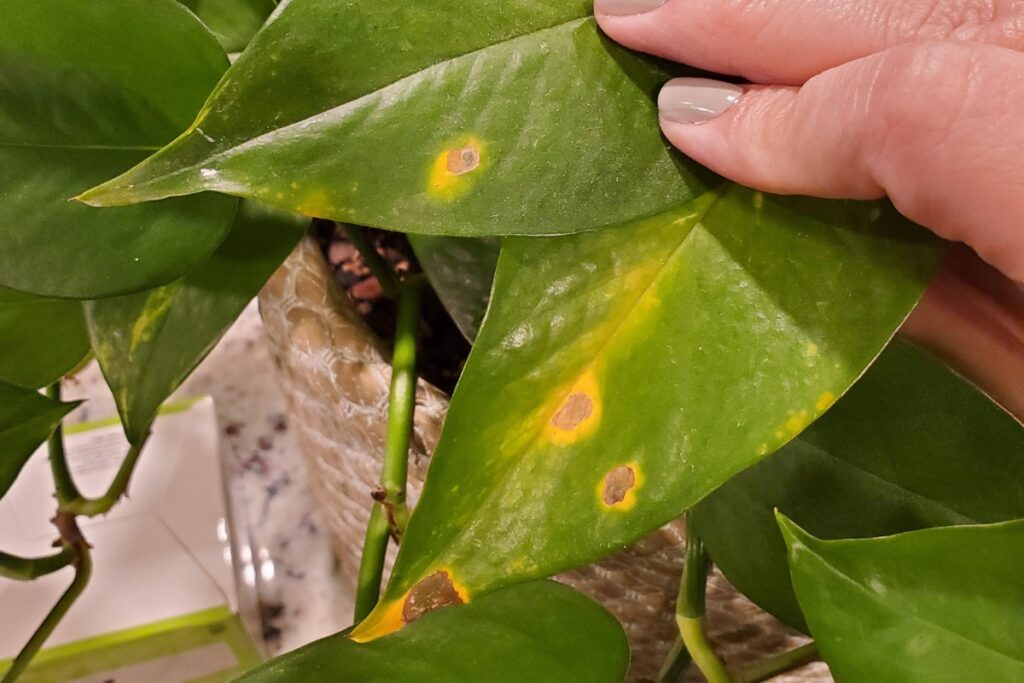Pothos plants typically thrive with minimal care, but several warning signs indicate when something goes wrong. Yellow leaves, drooping stems, and stunted growth suggest underlying problems that many plant owners overlook. Common culprits include incorrect watering schedules, poor lighting conditions, and nutrient imbalances. These issues often develop gradually, making them difficult to spot until significant damage occurs. Understanding these red flags helps plant enthusiasts identify problems early, though the specific solutions depend on pinpointing the exact cause.

Contents
- 1 Sunlight Problems That Damage Your Pothos
- 2 Watering Mistakes That Kill Indoor Plants
- 3 Soil and Pot Size Issues Affecting Growth
- 4 Temperature Stress and Environmental Changes
- 5 Pest Infestations Weakening Your Plant
- 6 Nutrient Deficiencies Causing Yellow Leaves
- 7 Root Bound Problems Limiting Development
- 8 Humidity Levels Impact on Plant Health
Sunlight Problems That Damage Your Pothos
How can something as essential as sunlight become a pothos plant’s worst enemy? The answer lies in intensity and placement. Direct sunlight scorches pothos leaves, creating unsightly leaf burn that appears as pale yellow patches. These damaged areas typically face the sun, while shaded portions remain vibrant green.
Conversely, insufficient light creates equally problematic conditions. Plants stretch toward available light sources, developing sparse foliage and losing their characteristic variegation. The solution involves finding that sweet spot: bright, indirect light that energizes without overwhelming. Position plants near windows with sheer curtains, or place them in well-lit rooms away from harsh rays.
Watering Mistakes That Kill Indoor Plants

Why do more pothos plants die from watering mistakes than any other care error? Simple: water affects everything from roots to leaves, and getting it wrong creates a cascade of problems.
Underwatering signs include curled leaves, dry stems, and leaf drop. Plants conserve moisture by pulling leaves inward, signaling distress. Bottom watering works best for compacted, dry soil.
Overwatering symptoms are more deadly, causing root rot within days. Mushy roots can’t absorb water, creating yellowing leaves and wilting stems. Stagnant water breeds harmful fungi and bacteria. Allow pots to dry completely between waterings, and trim any blackened roots immediately.
Soil and Pot Size Issues Affecting Growth
Even perfect watering won’t save a pothos stuck in heavy, compacted soil or squeezed into too small a container. Poor soil drainage creates waterlogged conditions that suffocate roots and invite rot. Dense, clay-like potting mixes prevent oxygen from reaching root systems, causing yellowing leaves and stunted growth.
When roots start emerging from drainage holes, it’s time for a bigger home. Choose a pot one to two sizes larger than the current container. Fresh, well-draining potting mix with perlite or bark helps water flow freely while retaining adequate moisture for healthy root development.
Temperature Stress and Environmental Changes
Where many gardeners focus solely on watering and light, temperature fluctuations often fly under the radar as silent plant killers. Pothos plants thrive in stable temperatures between 60°F to 80°F, but sudden changes can trigger stress responses like yellowing leaves and leaf drop.
Environmental stability matters more than perfection. Moving your plant from a warm room to a cold drafty area creates shock, while placing it near heating vents causes dehydration. Even relocating to different rooms disrupts their comfort zone.
Maintain consistent conditions by avoiding frequent moves and keeping plants away from temperature extremes for ideal health.
Pest Infestations Weakening Your Plant
While temperature stress weakens plants gradually, pest infestations can devastate a pothos in mere weeks. Common culprits include spider mites, mealybugs, and aphids that drain plant energy, causing yellowing leaves and stunted growth.
Pest identification starts with weekly inspections of leaf undersides and stems. Spider mites create fine webbing, while mealybugs appear as white, cotton-like clusters. Aphids cluster on new growth.
Treatment methods include insecticidal soap or neem oil applications every 5-7 days until eliminated. Isolate infected plants immediately to prevent spread. Consistent monitoring prevents minor issues from becoming major infestations that compromise plant health.
Nutrient Deficiencies Causing Yellow Leaves
Why do pothos leaves turn yellow despite proper watering and lighting? The culprit might be nutrient deficiency. Pothos plants require essential nutrients like nitrogen, potassium, and magnesium to maintain healthy green foliage. Without adequate nutrient sources, leaves gradually lose their vibrant color and turn yellow.
During spring and summer growing seasons, establish a consistent feeding schedule using balanced houseplant fertilizer. Feed monthly for ideal nutrition, then reduce frequency in fall and winter when growth slows. Monitor your plant’s response and adjust the feeding schedule accordingly to prevent both deficiency and over-fertilization issues.
Root Bound Problems Limiting Development
How can a pothos plant survive in the same pot for years, yet suddenly show signs of distress? The answer lies in root health deterioration. When roots circle the container’s bottom and emerge from drainage holes, the plant becomes root bound. This restricts nutrient uptake, causing yellowing leaves and stunted growth.
Repotting benefits include renewed vigor and enhanced development. Choose a container one to two sizes larger, ensuring proper drainage. Fresh, well-draining soil provides essential oxygen to cramped roots. The ideal repotting timeline occurs every two to three years, preferably during spring’s active growing season.
Humidity Levels Impact on Plant Health
Where thriving pothos plants once displayed glossy, vibrant foliage, struggling specimens often reveal the hidden culprit of inadequate humidity. These tropical natives demand moisture levels above 50% to maintain proper transpiration and photosynthesis.
Low humidity effects include stunted growth, brown leaf edges, and curling foliage as plants desperately conserve moisture. Misting provides temporary relief but risks fungal problems with poor air circulation.
Optimal humidity requires consistent environmental control rather than quick fixes. Place a humidifier within three feet of your pothos, maintaining 50-60% humidity levels. This steady approach prevents the stress cycles that damage plant health permanently.
